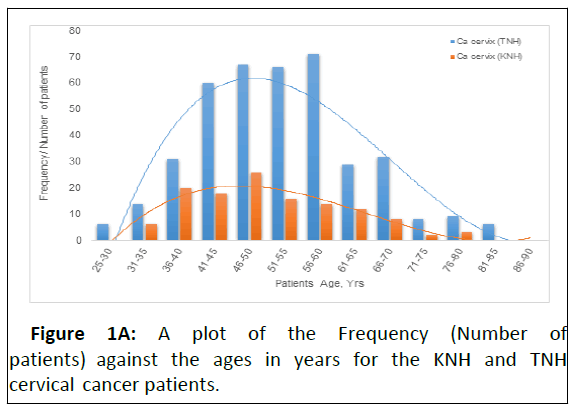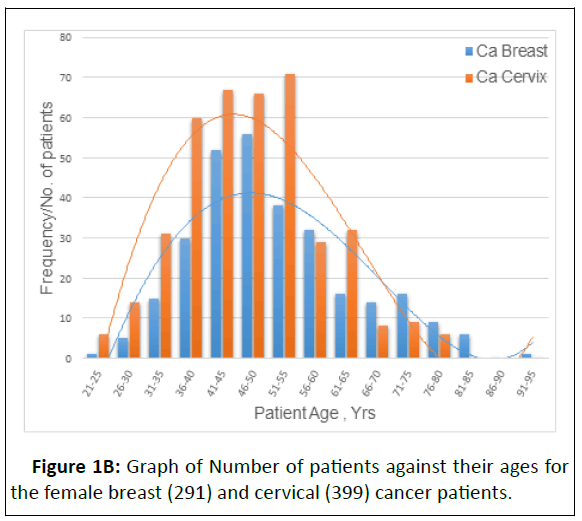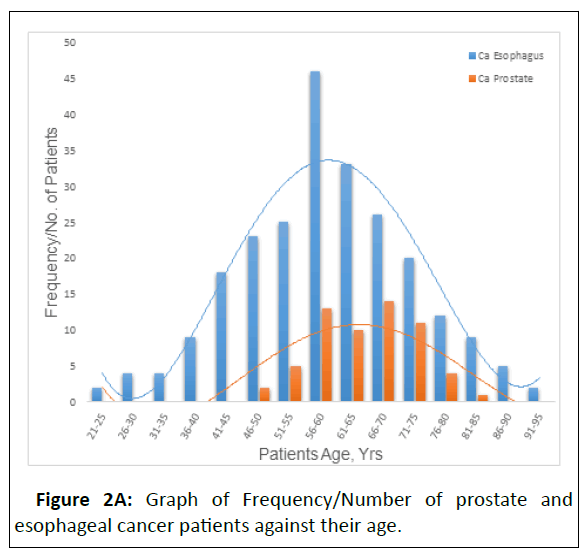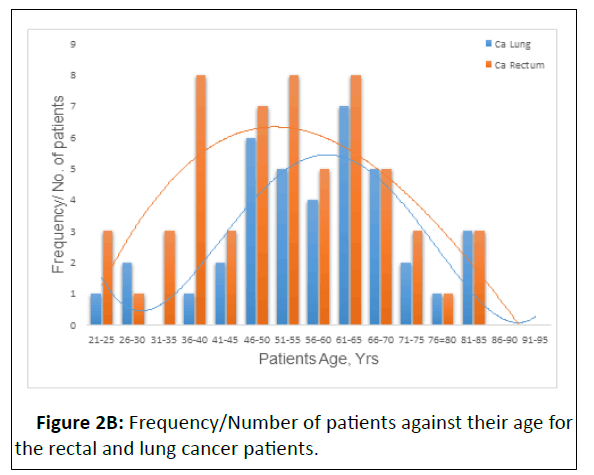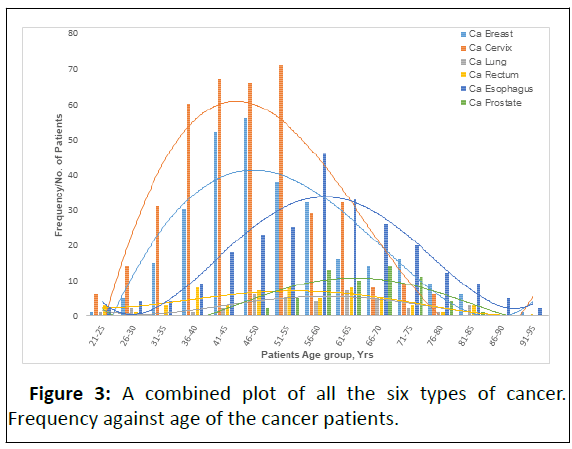Inter-Dependence of Type of Cancer, Age and Gender for patients on Radiotherapy Treatment in Kenya
Philip Kioko Ndonye, Samuel Nii Adu Tagoe
Philip Kioko Ndonye1,2*and Samuel Nii Adu Tagoe3
1Department of Clinical Medicine and Therapeutics, Kenyatta National Hospital (KNH), Nairobi, Kenya
2Department of Oncology and Cancer Treatment Centre, the Nairobi Hospital, Nairobi, Kenya
3Department of Biomedical and Allied Health Sciences, University of Ghana, Korle Bu-Accra, Ghana
- *Corresponding Author:
- Philip Ndonye
Department of Clinical Medicine and Therapeutics,
Kenyatta National Hospital (KNH), Nairobi, Kenya,
Tel: 711150081;
E-mail: pndonye@nbihosp.org
Received: February 18, 2022, Manuscript No.IPIMP-22-11817; Editor assigned: February 21, 2022, PreQC No. IPIMP-22-11817 (PQ); Reviewed: March 07, 2022, QC No. IPIMP-22-11817; Revised: March 11, 2022, Manuscript No. IIPIMP-22-11817 (R); Published: March 18, 2022, DOI: 10.36648/2574-285X.22.7.002
Citation: Ndonye PK, Tagoe SND (2022) Inter-Dependence of Type of Cancer, Age and Gender for Patients on Radiotherapy Treatment in Kenya. J Med Phys Appl Sci Vol:7 No:1
Abstract
Purpose: The aim was to investigate and determine the relationship between age, different types of cancer and gender for cancer patients undergoing radiotherapy treatment in Kenya.
Materials and methods: Hospital based statistical data of 1210 cancer patients on radiotherapy treatment from two cancer treatment centers in Kenya were assessed and analyzed for their relationship with age. Gender and type of cancer. The different types of cancer were cervical, breast, esophagus, lung, rectum and prostate.
Results: The mean age of the female cervical cancer patients treated at both centers (KNH and TNH) had mean age between 46-50 years, an indication of normal distribution of cancer; while the overall average age was 46 years. Also, the female breast cancer patients analysed had a mean age of 46-50 years and an overall average of 49 years.
The male prostate cancer patients considered for the investigation had a mean age of 62 years and within 61-65 years age bracket. The overall mean age of the rectum, lung and esophagus was 51, 57 and 59 years respectively.
Conclusion: Based on the above results, there is clear indication of age relationship with type of cancer and gender of the patients. Female breast and cervical cancer appeared at younger ages (46-50 yrs) compared to rectum, lung, esophagus and male prostate cancer. With a mean age of 62 years, male prostate cancer was indicated on patients at advanced ages (61-65 yrs) above 60 years on majority of our patients and as confirmed on past published results.
Keywords
Dependence; Cancer type; Age; Gender; Radiotherapy
Introduction
Cancer incidences are increasing every year particularly in low and middle-income countries; and the burden of cancer and other non-communicable diseases has now become enormous. This increase of cancer incidences in our country (Kenya) may be attributed to the rising population, limited cancer awareness, the growing adoption of unhealthy lifestyles, access to limited cancer treatment facilities and limited economic resources among other factors.
Many organizations and governments have stood together to seek for solutions to control and prevent cancer but there are quite many challenges involved. The WHO and the IAEA have been involved in advocacy and numerous actions to improve cancer control [1]. In Low and Middle-Income Countries (LMICs), the challenges to deal with cancer burden are now becoming out-of-control since the same countries are also dealing with communicable diseases. The 2011 Brazzaville Declaration on Non-communicable diseases, Prevention and Control in African Region; “affirmed the awareness of African governments about the increasing health danger from Non-Communicable Deceases (NCDs), including cancer [2].
The signatories undertook to develop strategies for prevention and control to strengthen their health systems to enable reduces the burden of NCDs, to source the finances required for fighting these disease, and to enable their national health information systems to generate data on NCDs and their risk factors. However, the progress in this direction is still slow, I quote.
From a survey initiated by WHO in the African Region in 2010, it was found that of the 46 respondent countries, only 17 had operational policies, strategies, or action plans for cancer [3]. Projected future rise in cancer incidences in developing countries demands increase for cancer services. Since inadequate cancer services have been cited among developing countries including Kenya, there is need to put funding projections in place for their future cancer treatment services [4].
Cancer has been designated the second most important cause of death among non-communicable diseases and its incidence is expected to rise in the coming decade [5]. According to WHO, the cancer incidence between 2008 and 2030 is expected to rise by 82%, 70% and 58% in Low, Low-Middle and Upper-Middle income countries respectively, compared to 40% in High-Income countries. Two thirds of the cases are expected in LMICs [6].
Cancer screening usually forms part of any cancer control program as early stage cancer has the best chance of cure. However, in LMICs with no or inadequate treatment facilities, early detection of cancer for which radiation therapy is indicated may force patients to bear the psychological trauma of living and suffering with untreated cancer. Thus, to make screening programs meaningful, they must be supported with adequate treatment facilities due to lack of cancer awareness coupled with unavailability or poorly managed cancer screening programmes to detect cancer at an early stage, our cancer patients appear for treatment at advanced stage, just like patients in other LMICs. Some minimal cancer screening programmes available in Kenya are for cervical. Breast, and prostate but they are not effective and the data/reports cannot be accessed due to lack of National Cancer Registry in place.
Material and Method
A total of 1210 different types of cancer patients being treated at two cancer treatment centres within the city of Nairobi were investigated and analysed for their ages and gender. Kenyatta National Hospital (KNH) is a public hospital where 125 cervical cancer patients were treated by use of Co-60 teletherapy equipment. The other 1085 types of cancer were being treated at The Nairobi Hospital (TNH), a private hospital, with Linear Accelerator photon beams. These were breast (291), cervical (399), lung (39), rectum (58), oesophagus (248) and prostate (60) cancer. Our investigation applied hospital based data for the patients undergoing radiotherapy treatment from the two hospitals.Three of the cancer types were sex dependent. Cervical and breast cancer for female and prostate cancer representing the male cancers. The other cancer types were mixed gender types. Since the number of male breast cancer patients was four out of a total of 291 patients, they were not assessed separately since their percentage was almost negligible. There were no demographic data available to correlate the cancer types on our country regional basis. Lung, rectum and oesophageal cancer affected both male and female patients although majority of the oesophagus patients were male.
Data for each type of cancer was analysed separately against the ages of the patients and gender. For convenience of presentation of results, ages of each cancer type were set in groups of respective five years and the results plotted in graphical form. A combined graph of all types of cancer against their ages is presented on Figure 1, while split graphs containing two cancer types are on Figure 2A, 2B and 2C.
Since we wanted to clearly demonstrate the dependence of type of cancer on patients’ age, the graph on Figure 3 shows that each type of cancer has a distinctive mean age.
Results and Discussion
Patients for cancer treatment by radiotherapy in Kenya have been increasing annually as captured from the treatment data at KNH in 2007-2012 and at TNH in 2013-2018 [6]. We had based our previous study of radiotherapy patients’ data on individual institutions (KNH and TNH) since we don’t have a populationbased national cancer registry in Kenya. Cervical cancer was identified as the most common cancer followed by prostate, breast, and esophagus respectively. So we decided to investigate the relationship between the types of cancer and ages of the patients for these four different types of cancer, plus lung and rectal cancer.
The increase in cancer incidence may be attributed to the rising population, limited cancer awareness, the growing adoption of unhealthy lifestyles as well as access to limited cancer treatment facilities.
In fact before 2012, there was only one public cancer treatment facility (KNH) against a population of about 40 million then. The patients seeking cancer treatment were many and would take several months before starting the treatment. Although the number of cancer treatment facilities has increased to three public and six private centers, the cost of treatment is still high and the available insurance cover is struggling to cope with the increasing number of patients. Just like in other countries in LMICs, majority of the patients are not aware of the disease, for example breast, until they discover a large palpable mass on their breast and that’s when they start seeking for health care [7].
Results of the investigated cancer patients were presented graphically by the average ages of different types of cancer. Ages of patients for each cancer category were placed in groups of five years for convenience of presenting the results graphically. A polynomial curve (power 4) presentation of the same data is also included on each graph. Ages for the 125 female cervical cancer patients treated at KNH were presented together with those 399 treated at TNH on Figure 1. The average age of the female cervical cancer patients in both graphs was between 46-50 years. This result clearly indicate that the cancer patients are normally distributed and independent of the institution of treatment or location in the country,
From the above polynomial graph for the female breast and cervical cancer patients, a mean age of 46-50 years was realized and an overall mean of 49 and 46 years respectively.
The mean age of our breast cancer patients was in agreement with other published results [8].
Analysis of the ages of the male prostate cancer patients presented on Figure 2A below, clearly indicate a mean age between 61-65 years.
Although some prostate patients contracted the disease at ages below 60 years from the graph, it is a clear indication that the disease is persistent in male patients above of 60 years of age; on 61-65 years age bracket, which is in agreement with other published results [9]. Although esophageal cancer is seen in both male and female patients, majority of our patients were male. Their combined mean age was 59 years on 55-60 age bracket (Figure 2A).
The mean age for the rectal and lung cancer patients analyzed had a mean age of 51-55 years and 56-60 years respectively. Their overall mean age was 51 and 57 years respectively. Demonstration of the variability between the six different types of cancer with age is presented graphically on Figure 3.
A summary of the results of Mean/Average ages for the six different types of cancer is on Table 1 and Figure 4 (Graph), which clearly show that each type of cancer was dependent on the patient’s age bracket.
| Type of cancer | Mean Age, Years | Mean Age (Range), Years |
|---|---|---|
| Ca Cervix | 46 | 46-50 |
| Ca Breast | 49 | 46-50 |
| Ca Rectum | 51 | 51-55 |
| Ca Lung | 57 | 56-60 |
| Ca Esophagus | 59 | 56-60 |
| Ca Prostate | 62 | 61-65 |
Table 1: A summary of the results of Mean/Average ages for the six different types of cancer.
In order to contain the cancer burden in Kenya, oncology clinical trials are needed to develop innovative interventions for cancer prevention, screening, diagnosis, treatment, and survivorship. Clinical trials are also needed to ensure that therapeutic interventions are safe and effective in the population. At the same time, a National population-based Cancer Registry needs to be initiated as a priority. Reports of early diagnosed cancers patients would normally be captured on the available screening programms, then proceed for treatment and the complete country data appears at the National Cancer Registry.
Cancer is curable when diagnosed and treated at an early stage. Majority of our patients come for treatment when the disease has advanced to late stage (for example at Stage III or Stage IV for breast or cervical cancer), while their ages are young. This was confirmed in other similar studies in Ghana for breast cancer [10,11].
Conclusion
The assessment of cervical cancer patients on treatment in the two different cancer centres revealed that the cancer patients were normally distributed and not dependent on the institution of treatment or location in the country. Also, there was clear indication of cancer type dependence on patients’ age. Female breast and cervical cancer patients contracted the disease at young age (46-50 years) compared to the male prostate cancer patients which had a mean age of in the age bracket of 61-65 years. Mean ages of breast and prostate cancer patients were in agreement with published results. Results of the mean ages of all the other mixed-gender cancer types composed of both male and female patients (Rectal, lung and esophageal cancer) had mean ages between the purely female and male cancer patients.
The summary of results also is an indication that there is a proportional relationship between the different types of cancer and mean age from female cancer ages on the lower age brackets to the male cancer ages on the upper age brackets.
Acknowledgements
I acknowledge my Institutions’ Ethics and Research Committee (Kenyatta National Hospital, University of Nairobi, and The Nairobi Hospital) for accepting and allowing me to do my PhD research project at the institutions.
References
- Abdel-Wahab M, Fidarova E, Polo A (2017) Global access to radiotherapy in Low and Middle –Income countries. Clin Oncol 29:99-104
- WHO (2012) United against NCDs: The time to act is now. The Brazzaville declaration on non-communicable diseases, prevention and control in the WHO African Region. WHO Africa
- Stefan DC (2015) Cancer Care in Africa: An Overview of Resources. JCO Global Oncology. J Glob Oncol 1;1:30-36
[Crossref] [Google Scholar] [PubMed]
- WHO (2011) 2001 Promises of Commitment and Solidarity. “The Abuja Declaration: Ten Years On”
- Hunter DJ, Reddy KS (2013) Non-communicable diseases. N Eng J Med 369:1336-1343
[Crossref] [Google Scholar] [PubMed]
- Ndonye PK (2018) Advances in Treatment of Cancer by Brachytherapy in Kenya, in Particular, Prostate Cancer. Med Phys Appl Sc 3:1-8
- Anderson BO (2014) Breast cancer in Sub-Saharan Africa: Where can we go from here? J Surg Oncol 110:901-902
[Crossref] [Google Scholar] [PubMed]
- Abigail ST, Kelly MK, Joseph KO (2017) Breast cancer in Ghana: Demonstrating the need for population-based cancer registries in Low and Middle-Income Countries. J Glob Oncol 3:765-772
[Crossref] [Google Scholar] [PubMed]
- Davis BJ, Horwitz EM, Robert Lee W (2012) American Brachytherapy Society consensus guidelines for trans-rectal ultrasound-guided permanent prostate brachytherapy. Brachytherapy 11:6-19
[Crossref] [Google Scholar] [PubMed]
- Ohene-Yeboah M, Adjei E (2012) Breast Cancer in Kumasi, Ghana. Ghana Med J 46:8-13
[Google Scholar] [PubMed]
- Clegg-Lamptey J, Hodasi WA (2007) study of breast cancer in Korle Bu Teaching Hospital: Assessing the impact of health education. Ghana Med J 41:72-77
[Crossref] [Google Scholar] [PubMed]
Open Access Journals
- Aquaculture & Veterinary Science
- Chemistry & Chemical Sciences
- Clinical Sciences
- Engineering
- General Science
- Genetics & Molecular Biology
- Health Care & Nursing
- Immunology & Microbiology
- Materials Science
- Mathematics & Physics
- Medical Sciences
- Neurology & Psychiatry
- Oncology & Cancer Science
- Pharmaceutical Sciences
